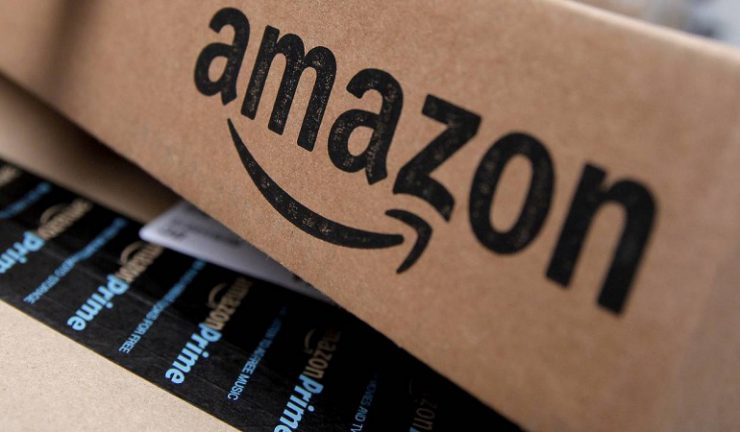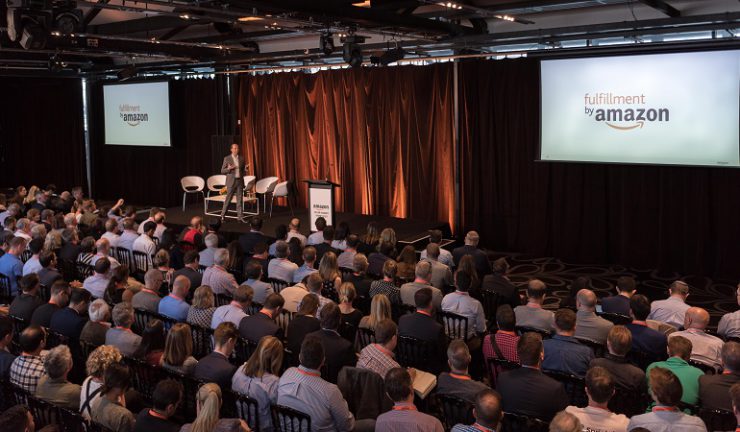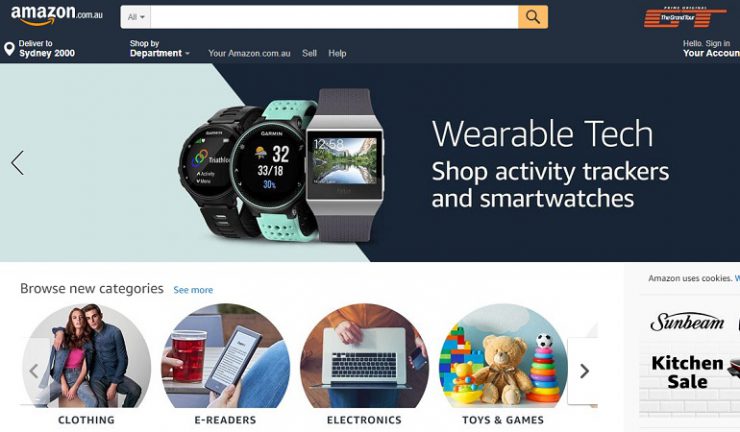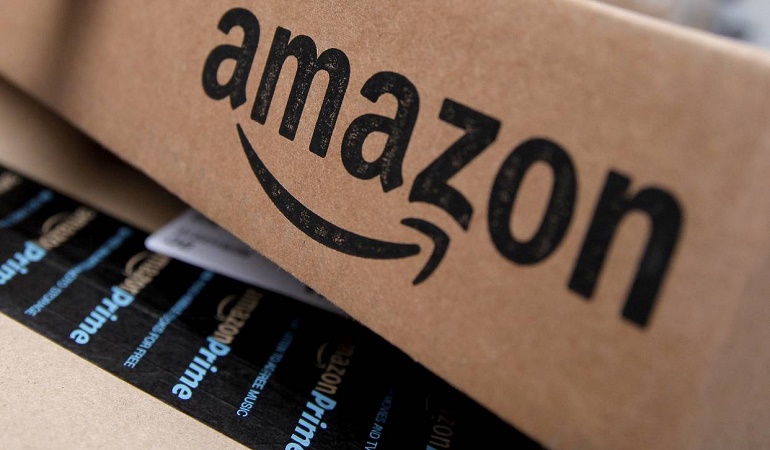Leading to official launch.
Amazon already became the talk of the town in 2016 with retail experts and executives weighing in on how the retail giant would impact the local retail landscape. In 2017, the hype of it all just became bigger.
Nielsen: 67% of Aussie customers may purchase electrical goods from Amazon
Nielsen Omnibus research shows that Amazon’s US site converts almost one-in-two (49%) Australian visitors into sales – the fourth highest behind eBay (78%), The Book Depository (74%) and The Iconic (53%).
However, more alarmingly for its competitors: 75% of Australians aged over 18 say they are interested in Amazon Australia; while 56% say they are likely to purchase from its Australian site; and 45% saying they would pay to become an Amazon Prime member to receive special deals, discounts and delivery perks.
The top products likely to be bought on the Australian Amazon site include:
- Electrical goods
- Books
- Clothes
- Shoes
- Music
Amazon will also offer free delivery on its products and prices are expected to be discounted as much as 30%.
April: Amazon confirms arrival
Amazon confirmed that it was actively looking for a fulfilment centre in Australia. According to Fairfax media reports, it signed a lease deal for a large purpose-built warehouse at Eastern Creek in Sydney’s west.
In a statement supplied to Appliance Retailer, Amazon said, “We are excited to bring thousands of new jobs to Australia, millions of dollars in additional investment, and to empower small Australian businesses through Amazon Marketplace. We are optimistic that by focusing on the things we believe customers value most – low prices, vast selection, and fast delivery – over time we will earn the business of Australian customers.”
On Thursday, Amazon launched a banner on its Australian website, confirming that Amazon Marketplace “is coming soon to Australia” and called for businesses to sign up and learn how to start selling to millions of Australian consumers.
Sales through Amazon Marketplaces now represent 50% of all items sold on Amazon websites globally and there are already thousands of Australian businesses selling their products on existing Amazon Marketplaces.

May: Leading analyst offers key tips to retailers
One of the world’s leading consumer technology analysts has revealed some key tips for nervous Australian retailers ahead of the arrival of Amazon over the next few months.
Paul Gray, principal analyst for consumer devices at London-based IHS Markit, has used selling televisions as a case study for fighting the might and power of Amazon’s online business with the unique dynamics offered by an instore-experience.
“My advice to bricks and mortar retailers is to invest in your in-store experience, and then train, train, train your staff. Think long-term and make your stores bright and welcoming and also ensure your staff bright and welcoming as well,” he said at the recent IFA Press Conference in Lisbon.
“Nobody said this was easy. Amazon is a formidable company and the scary thing is that they have so much more data about that person than you do when somebody walks in off the street – and for a bricks and mortar retailer that’s terrifying – including what they looked at last time, what they clicked on last time and how much they spent.
“But while they have that – they don’t have what a bricks and mortar store has and that’s physical presence,” he said.
“A lot of products like TVs are not just screens – they are furniture and you have to think about selling that in a different way and that ultimately comes down to an experience. Nobody can hear the audio on the internet, nobody can see the resolution on the internet, nobody can have the experience of a premium TV with the sound turned up. So you have to sell them the fairground ride, show them what good picture quality is like and get them to feel what proper audio is like – sell the experience.”

June: BAML analyst – the hype is not validated
It may be difficult for Amazon to capture as much local market share as what has been predicted by other analyst firms, according to Bank of America Merrill Lynch analyst David Errington. He believes the Australian market presents a number of road blocks for the online retail giant including a restrictive logistics infrastructure, supply chain concerns and the fact key global online retailers already operate and have a presence here.
“We believe bricks-and-mortar retailing forms an integral part of successful retailing in the Australian market and this is somewhat distinct to other markets where population densities are higher. A large network, which the major retailers such as Wesfarmers and Woolworths have access to, including a bricks-and-mortar offer, is required to be truly disruptive in Australia,” he said.
Writing to clients, Errington argues Australia has, relative to world standards, an advanced online retail market, and that when also considering the relatively low population density of Australian cities, particularly against cities in the US, Britain and parts of Asia.
“In our opinion, the view that Australia is not as progressed in online retail and is susceptible to a new or expanded offer from Amazon or any other new competitor is not substantiated by fundamentals,’’ Errington said.
July: Amazon settles warehouse, posts job ads
Amazon will lease the former Bunnings distribution centre, measuring 24,387 square metres, in Melbourne’s Dandenong South, according to an Australian Financial Review report, which suggests that the vacant warehouse could double in size to suit Amazon’s needs.
The site is owned by one of Melbourne’s largest privately-owned construction, development and investment businesses, Pellicano Group. The Group has been contacted for comment.
Amazon has a number of positions advertised for the new Dandenong South warehouse, including loss prevention manager, studio manager, public relations manager, and most notably an area manager and operations manager.
Amazon has also posted over 130 job vacancies in Sydney on its Australian website, including a supply chain manager, senior in-stock manager, merchant product manager and compliance country lead.
August: Amazon appoints country manager
An Amazon spokesperson has confirmed that Amazon director of consumables for Germany, Rocco Braeuniger will move to the role of country manager for Amazon Australia in the coming months. He joined Amazon in 2006 and has held a variety of positions during his 11 years at the company.
He holds a diploma from the University of Bayreuth in Germany and Master of Business Administration from Babson College in the US.

September: Australian Ombudsman asks Amazon to review contract terms
The Australian Small Business and Family Enterprise Ombudsman has written to Amazon to ensure the company complies with Australia’s unfair contract terms legislation. Ombudsman Kate Carnell said the pending arrival of Amazon Marketplace in Australia represented an opportunity for many small businesses to compete online and extend their reach. However, Carnell also wants to remind the company of its obligation to treat small businesses fairly in accordance with Australian law.
“Some businesses are concerned about the threat of competition while others are excited to embrace the opportunity that Amazon offers. For consumers the Amazon Marketplace promises to expand choice and put downward pressure on prices. I am interested to see how Australian small businesses can accelerate sales and broaden their customer base though the Amazon platform.”
Analysis of the Amazon Marketplace contract terms in the United States suggested they would have to be changed in Australia to comply with federal legislation, Carnell said.
An Amazon spokesperson responded to this announcement with the following statement:
“We look forward to launching Amazon Marketplace in Australia and providing thousands of small businesses and entrepreneurs with tools and services that help them to reach millions of customers and to expand their businesses both here and abroad. We will, of course, adhere to all local laws in relation to our agreements with Marketplace sellers.”
November: Amazon hosts Seller Summit in Sydney
Amazon was host to its Marketplace Seller Summit in Sydney with Amazon Australia country manager, Rocco Braeuniger and head of Amazon Marketplace in Australia, Fabio Bertola in attendance. A panel of Australian retailers already selling on Amazon, including KoalaSafe, Hip Cup, Third Sigma and Gobe, also discussed how they have benefited from listing their products on Amazon’s marketplace.
Although, Braeuniger did not confirm an exact date for the company’s local launch, only stating it would be “really, really soon”, it has been tipped to coincide with the Black Friday and Cyber Monday sales period next week.
When Amazon opens, it will be selling products from its warehouse in Dandenong in Melbourne and from third parties through its marketplace. Furthermore, sellers will benefit from 15-day terms and simply need to provide a return address for any product returns.
Amazon will also aim for a two-day delivery turnaround from its fulfilment centre and local sellers will be able to reach consumers from around the world. Therefore, geo-blocking would not be implemented.
“We are excited to work with many thousands of Australian businesses to help them reach more than 300 million customers around the world and to grow their business. We want to encourage and educate Australian businesses on how they can use Amazon Marketplace to take their products to a global audience. With more than half of units sold globally coming from Marketplace sellers, we know that customers love the unique selection that they bring,” Braeuniger said.

December: The much-anticipated arrival
On Tuesday 5 December, Amazon officially launched its Australian retail offering.
Amazon.com.au features a wide selection, including Books, Video Games, Consumer Electronics, Sports & Outdoors, Tools, Toys, Home Improvement, Beauty, Clothing & Accessories, Shoes and Amazon Devices, such as our Kindle E-reader and Fire TV Stick devices. Customers can enjoy free delivery on eligible orders above $49 that are sold by Amazon. A one-day delivery service is available in select areas across Australia.
The selection at Amazon.com.au includes millions of products offered by well-known Australian brands, as well as small and medium-sized Australian businesses selling on Amazon Marketplace. Globally, approximately 50% of Amazon’s total units come from Marketplace sellers.
Customer orders will be fulfilled from Amazon’s new fulfilment centre in Dandenong South. Amazon also has corporate offices in Sydney, Melbourne, Perth, Brisbane and Canberra which are home to more than 1,000 employees.
Amazon expects to launch Prime shipping benefits in Australia in mid-2018 and from today Australian customers can register at www.amazon.com.au/prime for more information about Prime. Prime offers tens of millions of members around the world an unparalleled combination of shipping, shopping, and entertainment benefits.

December: Retailers react to arrival
Harvey Norman chairman, Gerry Harvey
Despite the substantial expectations for Amazon on local turf, Gerry Harvey believes the official launch was overhyped, and not to mention, “crazy” in its timing.
“It’s bizarre that Amazon would launch so close to Christmas. If customers order something from them, heads they get it, tails they don’t. If I were them, I would have launched in February or even later, sometime after the busy Christmas period. There has been so much hype from media and retail analysts and now that they have launched, it’s a lame duck.”
Winning Group CEO, John Winning
Amazon’s launch is not concerning John Winning as he and his team have been planning for the arrival since the inception of Appliances Online 12 years ago.
“Australia is one of the most difficult continents to deliver in and we have made a significant investment in developing our national logistics network to a point where we have the best bulky good delivery team in Australia.
“With Christmas fast approaching it will make it tough to have stock delivered in time. One of my colleagues this morning went to order a $4.99 water bottle and even though it was in stock, it wouldn’t be delivered until 10th January. Amazon’s three-tier delivery service model is price differentiated based on location, charging as much as $20 for deliveries to remote locations.
“I presume we will see a much stronger Amazon next year and when Amazon Prime becomes available in mid-2018, it will make them a stronger competitor, but it will only give customers a service that we already offer for free; next day delivery,” he said.
Betta Home Living CEO, Graeme Cunningham
“We need to be preparing for competitors regardless of type – Amazon is just one of these. We will be improving our digital performance, and our logistics offering as well as our in-store experience. Every touchpoint of our customer experience needs to be reviewed. As the franchisor there is only so much we can do as there are several aspects that our stores have to execute such as presentation in store right through to the delivery drivers.
“Amazon does not have a few things – and one of them is shopfronts and we have over 200 pick-up locations throughout Australia. Best Buy has been able to take the fight to Amazon in the US by increasing their online sales with pick-up instore. There is no other country where Amazon works like America and to put this in perspective when you look at the available data – around $120 billion of their $170 billion forecasted turnover is from the US market. Amazon also took advantage of an over-supply of bricks and mortar retailers in the US market that was a problem waiting to happen for many years, particularly department stores.
“Ultimately, it is competitors that we have to be prepared for whether they are online or bricks and mortar. We also need to lift our customer’s expectations and as retailers this is going to be an ongoing challenge into the future.”
Bi-Rite Home Appliances category manager, Hamza Hussein
“It was a fairly underwhelming launch and he was expecting a lot more of an offering. Having said that, it may be an unfair statement as Amazon did not state what to expect and still has not said a word to the public. So far it is still everyone within the industry and media who hyped up Amazon’s arrival. My concern is not so much today’s purchasing habits of consumers, but habits in the next 5 to 10 years. It’s a slow burn that should definitely be seen as a threat regardless of first impressions,” he said.
Electrical Discounters director, Tom Antonio
“It’s business as usual. We provide service, knowledge and advice on products and how they will suit individual requirements. When they purchase from any one of our four stores, customers have peace of mind because they are dealing with people they know and trust on the spot. If a refrigerator, washing machine, dishwasher, television, or any other product, breaks down, we are there to service them immediately as we know people cannot go without them, even for one day.”
Kogan founder and CEO, Ruslan Kogan
“There is no doubt that the way people buy goods and services in Australia has undergone significant change in the past decade. It is a wave of change that continues with great pace and we are proud to have played a key role in it. Saying that, we operate in a dynamic market and we expect that wave of change to accelerate as commerce in Australia undergoes structural change.
“Online retail is still under-represented in Australia compared to other major developed economies. Today online retail represents about 7.5% of the total Australian retail market. For economies with a large marketplace player such as Amazon or Alibaba, online retail penetration is closer to 20%.
“While Amazon is already a major force in Australia as a top 25 site, the launch of a local presence will undoubtedly bring more shoppers online. With traditional channels facing continued consolidation, the path to market in Australia is begging for diversification. We expect the evolution of the local retail market to drive some significant behavioural shifts – causing customers to rethink how they buy and suppliers to rethink how they distribute their inventory.
“For Kogan.com this represents an opportunity to drive incremental sales through additional platforms and channels – just as we benefit from eBay and TradeMe as a platform for Kogan’s suite of exclusive brands.”
Myer spokesperson
“Myer is focused on providing its customers with the best possible Christmas experience both in-store and online. We will continue to play to our strengths: providing leading brands, experiences and service. These are things that set us apart from our competitors and represent a real point of difference for Myer. As part of the New Myer Strategy we are continuing our focus on building and growing our omni-channel offering, with growth in our online sales of 41% in FY17, on top of strong growth in the prior year.”

